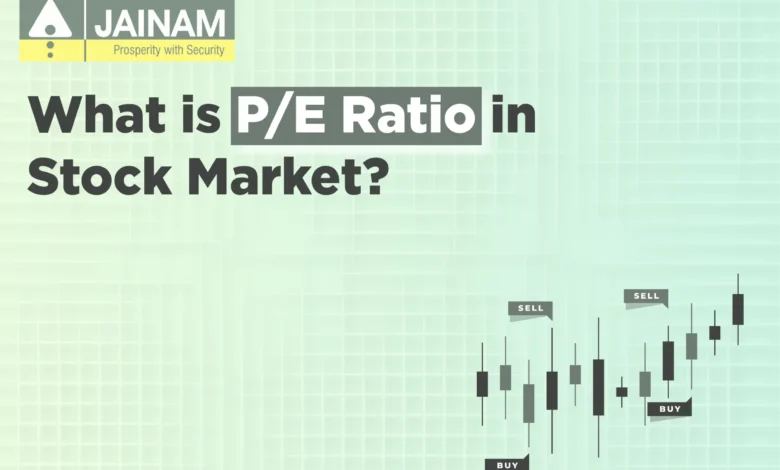
[ad_1]

Introduction
When investing in the stock market, one of the most commonly used valuation metrics is the P/E ratio (Price-to-Earnings Ratio). It helps investors determine whether a stock is overvalued or undervalued by comparing its price to its earnings per share. Understanding the P/E ratio in the stock market is crucial for making informed investment decisions.
Investors often rely on the P/E ratio to analyze companies, compare them within industries, and make better investment choices. However, while the P/E ratio in the share market is useful, it is not a standalone metric, and investors should be aware of its limitations.
In this blog, we will cover what is PE Ratio is, how it is calculated using the PE ratio formula, and how it can be used to evaluate stocks. We will also explore key aspects such as industry PE, best PE ratio, and the significance of stocks with high PE ratios and negative P/E ratios.
About the P/E Ratio
The P/E ratio is a crucial financial metric that provides insight into a company’s valuation. It is a ratio that compares a company’s stock price to its earnings per share (EPS). Investors use it to determine how much they are willing to pay for each unit of earnings.
The P/E ratio serves as a benchmark to evaluate a stock’s attractiveness. A high P/E ratio generally indicates that investors expect strong future growth, while a low P/E ratio may suggest undervaluation or lower growth expectations. It is a widely used valuation tool in fundamental analysis, helping investors decide whether a stock is overvalued or undervalued in the market.
While useful, the P/E ratio should not be the sole criterion for investment decisions. Investors must consider industry trends, economic conditions, and company-specific fundamentals to get a holistic view of a stock’s potential.
You may also want to know what is P/E Ratio?
Understanding PE Ratio
What is the P/E ratio?
The P/E ratio is a financial metric that compares a company’s stock price to its earnings per share (EPS). It indicates how much investors are willing to pay for each unit of earnings. This makes it a useful tool for determining a stock’s valuation relative to its peers.
A P/E ratio provides insight into market sentiment regarding a company’s future profitability. A higher P/E ratio suggests that investors expect significant growth in the company’s earnings, often seen in high-growth industries such as technology or consumer goods. Conversely, a lower P/E ratio may indicate that the stock is undervalued or that the company is facing financial challenges.
It is important to analyse the P/E ratio in conjunction with other financial metrics, such as revenue growth, return on equity (ROE), and industry benchmarks, to get a complete picture of a stock’s potential. Additionally, the P/E ratio should be viewed in the context of broader economic conditions, market trends, and investor sentiment.
What is the P/E Ratio in the Share Market?
In the share market, the P/E ratio helps investors gauge the profitability and growth potential of a company by comparing its price to its earnings per share. A high P/E ratio in the stock market suggests that investors expect strong future growth, while a low ratio may indicate undervaluation or weak future prospects.
A stock’s P/E ratio can vary widely based on market conditions, industry standards, and company performance. Growth stocks often have a higher P/E ratio, whereas value stocks typically trade at lower multiples.
What is P/E in the Stock Market?
Investors widely use the P/E ratio in the stock market to compare different companies within the same industry. Investors use it as a benchmark to determine whether a stock is fairly valued, overvalued, or undervalued based on its earnings. By analyzing the P/E ratio, investors can determine how much they are paying for each unit of earnings generated by a company.
A high P/E ratio suggests that investors have high expectations for a company’s future growth, often seen in rapidly expanding industries such as technology, pharmaceuticals, and consumer goods. These companies are expected to generate higher earnings in the future, justifying a premium valuation. However, a high P/E ratio does not always mean a stock is a good investment; it could also indicate overvaluation, where the stock price is too high relative to its actual earnings potential.
Conversely, a low P/E ratio may signal an undervalued stock, meaning it is trading at a lower price compared to its earnings. This can be a sign of a good investment opportunity if the company has strong fundamentals and growth prospects. However, a low P/E ratio could also indicate poor financial performance or declining business prospects, which is why additional research is necessary.
Investors should not rely solely on the P/E ratio when making investment decisions. Market conditions, industry trends, economic factors, and company-specific fundamentals all play a role in determining whether a stock is a good buy. By comparing the P/E ratio to industry averages and historical performance, investors can gain a clearer picture of a stock’s true valuation.
PE Ratio Formula and Calculation
PE Ratio Formula Explained
The PE ratio formula is a key valuation metric:
This formula helps investors assess the cost of buying ₹1 of a company’s earnings. It is an essential tool in financial analysis and helps in comparing stocks.
Example Calculation of PE Ratio
For example, if a company’s stock price is ₹200 and its earnings per share (EPS) is ₹10, the PE ratio will be: This means investors are willing to pay ₹20 for every ₹1 of earnings.
Understanding the PE Ratio formula is important because it provides a standardized way to compare different companies. However, investors must also look at historical PE ratios and industry benchmarks to gain meaningful insights.
Interpreting PE Ratio
Best PE Ratio for Investments
There is no universal “best” PE ratio, as it varies depending on industry trends, market conditions, and a company’s growth potential. The PE ratio serves as a relative valuation metric, with “high” or “low” values depending on the industry average and historical benchmarks.
Low PE Ratio (Undervalued Stocks)
A low P/E ratio (typically below 15) suggests that a stock may be undervalued. Investors might view such stocks as potential bargains, especially if the company has strong fundamentals. However, a low P/E ratio does not automatically mean a stock is a good buy; it could also indicate slow growth, declining earnings, or underlying financial issues.
Who Prefers Low PE Stocks?
- Value Investors look for stocks with a low P/E ratio, believing that the market has underpriced them and that they may provide good long-term returns.
- Dividend Investors also favour low P/E stocks, as these companies are often more stable and generate consistent earnings.
Stocks with High P/E Ratio (Growth Stocks)
A high P/E ratio (above 25) suggests that investors have high expectations for a company’s future earnings growth. High P/E ratio stocks are often found in fast-growing sectors like technology, healthcare, and consumer discretionary industries.
Who Prefers High PE Stocks?
- Growth Investors target stocks with a high P/E ratio because they believe the company will expand rapidly, leading to higher future earnings.
- Momentum Investors prefer high P/E stocks, betting on continued price appreciation due to market optimism.
Industry PE and Its Importance
Comparing a stock’s P/E ratio to the industry’s P/E is crucial. Different industries have average P/E ratios based on their growth potential and risk levels. For example:

- Technology sector: High P/E ratios (25–50) due to rapid innovation and growth.
- Banking sector: Low PE ratios (10–15) due to stable and predictable earnings.
- Retail sector: Moderate PE ratios (15–20) depending on consumer demand trends.
If a stock’s PE ratio is significantly higher than its industry PE, it may be overvalued, while a PE ratio lower than the industry average could indicate an undervalued stock.
Finding the Right Balance
Investors should not rely solely on the P/E ratio when making investment decisions. Instead, they should analyze:
- Earnings growth: A rising P/E ratio can be justified if the company’s earnings are expected to grow significantly.
- Debt levels: Companies with high debt and a high P/E ratio may be riskier investments.
- Market conditions: During economic booms, PE ratios tend to be higher, while in recessions, they may drop.
By balancing these factors, investors can determine whether a stock’s PE ratio aligns with their investment strategy.
Industry PE and Its Significance
The industry PE ratio represents the average price-to-earnings ratio of all companies within a particular sector. It is calculated by taking the weighted or simple average PE ratio of multiple companies in the same industry. This metric provides a benchmark that helps investors assess whether a specific company’s PE ratio is high, low, or in line with the overall industry trend.
Why Industry PE Matters?
Investors compare a stock’s PE ratio with the industry PE to determine whether it is overvalued or undervalued relative to its peers. A company trading at a P/E ratio higher than the industry average may indicate that investors have high expectations for its future growth, whereas a P/E ratio lower than the industry average might suggest undervaluation or slower growth potential.
Example: Industry PE in Action
For example, suppose the average PE ratio for technology stocks is 35, and a particular tech company has a PE ratio of 40. In that case, it suggests that the stock is trading at a premium compared to its peers. Investors believe this company has better growth prospects than its competitors. On the other hand, if another tech stock has a PE ratio of 25, it may indicate that the stock is undervalued, or it could signal weaker expected earnings growth.
How to Use Industry PE Effectively?
- If a company’s P/E is significantly above the industry average, investors should analyze whether the growth expectations are justified.
- If a company’s P/E falls significantly below the industry average, investors should determine whether the stock is genuinely undervalued or if the company is facing challenges.
- Investors should compare the PE ratio with historical trends to see if the company’s valuation has deviated from its normal levels.
Thus, industry PE is an essential metric that allows investors to put a company’s PE ratio in perspective and make more informed investment decisions.
Types of PE Ratios
The Price-to-Earnings (P/E) ratio measures a company’s current share price relative to its earnings per share (EPS) and serves as a widely used valuation metric. Investors calculate the P/E ratio in different ways based on the time frame and the type of earnings considered.

Trailing P/E Ratio:
This is the most common method of calculating the P/E ratio. It uses the company’s earnings over the past 12 months (trailing 12 months or TTM). This ratio gives a snapshot of how the market is pricing the stock relative to past earnings performance.
- Formula: Trailing P/E Ratio = Current Share Price / Trailing 12-Month EPS
- Implication: It reflects the market’s view of past performance. However, it might not be accurate for companies experiencing significant growth or decline in their earnings.
Forward P/E Ratio:
The forward P/E ratio uses forecasted or projected earnings for the next 12 months. This is more useful for assessing the future growth prospects of a company. Analysts often use this ratio to predict how much investors are willing to pay for each unit of future earnings.
- Formula: Forward P/E Ratio = Current Share Price / Estimated EPS (next 12 months)
- Implication: It’s often used for growth stocks but carries more uncertainty, as the future earnings estimates may not always be accurate.
Shiller P/E (Cyclically Adjusted P/E or CAPE):
This version of the P/E ratio smooths out earnings by adjusting for inflation and using a 10-year average of real (inflation-adjusted) earnings. It’s particularly useful for long-term investment perspectives because it helps remove the noise of short-term market fluctuations.
- Formula: Shiller P/E Ratio = Current Stock Price / (10-Year Average of Inflation-Adjusted Earnings)
- Implication: The Shiller P/E provides a long-term valuation metric, helping to avoid misleading conclusions that could arise from short-term earnings volatility.
Stocks with High P/E Ratio
A high P/E ratio typically indicates that investors expect high growth in a company’s future earnings, which justifies a higher price. The ratio often reflects investor optimism and market confidence in the company’s ability to expand its profits.
Common in Growth Sectors:
Technology, biotech, and consumer goods sectors often exhibit high P/E ratios. This is because investors believe these companies will generate substantial earnings growth in the future, even if the earnings are currently low or negative. For instance, companies like Tesla and Amazon have historically traded at higher P/E ratios due to their rapid growth expectations.
Growth Potential:
A high P/E ratio suggests the market is willing to pay a premium for the company’s stock, anticipating that it will deliver strong earnings in the future. For example, tech companies investing heavily in research and development often have high P/E ratios because investors expect future breakthroughs or market dominance.
Risk Consideration:
While a high P/E ratio signals growth potential, it also comes with a higher risk. If the company fails to meet earnings expectations, its stock price may experience a sharp decline. Investors might encounter a situation where a stock becomes overvalued, with its price disconnected from its actual earnings potential. In this case, even strong companies can see their stock prices drop, especially if broader market conditions change or if the company’s growth slows unexpectedly.
Example:
A tech company with a P/E ratio of 40 might indicate that investors believe it will significantly grow its earnings in the coming years. However, if the company fails to meet these expectations, investors could lose a considerable portion of their investment.
Negative P/E Ratio and Its Implications
A negative P/E ratio occurs when a company reports negative earnings, meaning it has lost money over the analysed period. This typically arises when a company is in its early growth stages, has incurred high startup costs, or is going through a difficult period.
Causes of Negative P/E Ratios:
- Startups and Early-Stage Companies: Many startups, particularly in sectors like technology and biotechnology, operate at a loss in their early years. They may be investing heavily in research and development, marketing, and infrastructure in anticipation of future profits. For instance, Ola in India incurred significant losses during its early years while focusing on scaling its business model and expanding across cities.
- High Capital Expenditures: Companies in industries like energy, biotech, and pharmaceuticals may spend large amounts of capital to fund future growth, resulting in losses in the short term.
- Market Conditions: In certain market conditions, even well-established companies might experience losses due to increased competition, changes in consumer behavior, or shifts in industry regulations.
Risks of Investing in Companies with Negative P/E Ratios:
- Financial Instability: A negative P/E ratio often signals that the company is in financial distress. If the losses persist, it could lead to bankruptcy or the need to raise additional capital, which might dilute current shareholders’ equity.
- Investor Sentiment and Volatility: The market may view companies with a negative P/E ratio as risky investments, leading to higher volatility in the stock price. Even companies with high growth potential may see their stock prices drop if they do not show a clear path to profitability.
- Future Profitability: While a negative P/E ratio can signal losses, it can also be an opportunity for investors to buy into a company at a discounted price. If the company successfully turns around its operations and starts generating profits, the stock price can appreciate significantly. However, this requires careful due diligence and an assessment of the company’s potential for future earnings growth.
What to Consider:
- Revenue Growth: Even if a company has a negative P/E ratio, it might still show strong revenue growth, indicating that the business model is working and may eventually become profitable.
- Business Model and Strategy: Investors need to evaluate whether the company’s losses are due to strategic investments in future growth or if they are a result of poor management or structural issues in the business model.
- Industry Trends: A negative P/E ratio in high-growth industries like technology and biotech might be more acceptable if the company’s losses are part of an ongoing, planned expansion phase.
- Time Horizon: Long-term investors who are comfortable with risk may view companies with negative P/E ratios as an opportunity to buy early in a company’s growth journey, while short-term investors might be wary of the associated risks.
Open free demat account in 5 minutes
Conclusion
The P/E ratio in stock market is a valuable tool for evaluating stocks, but it should not be used in isolation. Investors should also consider other financial metrics, industry trends, and market conditions before making investment decisions.
While the P/E ratio is helpful, it has limitations. It does not account for future earnings potential, economic conditions, or company-specific risks. Investors should use it alongside other financial indicators like the PEG ratio, debt-to-equity ratio, and return on equity (ROE).
By understanding the P/E ratio in share market investing, investors can make better-informed decisions and build a strong stock portfolio.
So, are you planning on trading in the stock market? If yes, you are at the right place!
Open a Free Demat Account with Jainam Broking Ltd. Now!
[ad_2]
publish_date]








